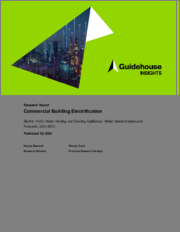
|
시장보고서
상품코드
1563117
세계의 상업용 건물 전기화 시장 : 전동식 HVAC,급탕기,조리 기구 - 시장 분석과 예측(2024-2033년)Commercial Building Electrification - Electric HVAC, Water Heating, and Cooking Appliances: Global Market Analysis and Forecasts, 2024-2033 |
||||||
기업이 이산화탄소 배출량을 줄이고 에너지 효율을 높이는 것을 목표로, 상업용 건물의 전기에 대한 수요는 지난 10년간 증가하고 있습니다. HVAC(냉난방,공조)나 급탕,조리 등의 시스템을 전화함으로써, 빌딩의 소유자나 기업은 에너지 효율의 향상, 이산화탄소 배출량의 삭감, 보다 안전한 건축물이라고 하는 이점을 얻을 수 있다 할 수 있게 되었습니다. 게다가 신재생에너지의 가용성이 높아짐에 따라 건축물의 전기화가 보다 바람직합니다. 완전히 전기화된 건축물에 신재생 에너지를 공급함으로써 건축물의 소유자와 사업주는 건축물이 제로 방출을 생성한다고 주장할 수 있습니다.
상업용 건물의 전기는 에너지 절약,지속가능성 추진,규제 준수의 필요성에 더해 이용 가능한 인센티브와 에너지 회복력에 대한 요망으로 최근 가속화되고 있습니다. 그러나 제품비용이나 설치비용이 높고 신기술이 복잡하다는 점, 전기의 장점을 충분히 누리려면 재생가능에너지와 결합해야 하는 등 시장성장률은 억제되고 있습니다.
이 보고서는 상업용 건물의 전기 시장에 대해 종합적으로 분석하여 최근 시장 동향, 촉진 및 억제요인을 밝힙니다. 또한 10년간의 예측을 보여 세계의 5개 지역(북미, 유럽, 아시아태평양, 라틴아메리카, 중동 및 아프리카), 4개의 기술 분야(히트펌프, 전기냉동기, 전기온수기, 전기조리기구), 2 1개의 건설 단계(신축, 개수), 8개의 상업용 건물의 유형(오피스, 소매점, 교육 시설, 의료 기관, 호텔 및 레스토랑, 공공 기관/회의장, 창고, 교통기관)마다, 향후 시장의 궤적에 대한 인사이트을 제공합니다.
목차
제1장 주요 요약
제2장 시장 문제
- 정의
- 동향
- 시설 관리에 있어서의 숙련 노동자의 부족
- 전기와 재생 가능 에너지의 융합
- 화석연료의 가격과 공급
- 전력망 부하의 우려
- 성장 촉진요인
- 법률상의 의무와 건축 기준
- 전기의 인센티브와 리베이트
- 지속가능성에 대한 노력
- 에너지 회복력
- 조리기구의 안전성과 건강상의 이점
- 억제요인
- 기술비용 높이
- 법령에 대한 반발과 저항
- 인프라 제한
- 고객의식과 교육
- 주요 이해관계자간 조정 부족
제3장 산업 밸류체인
- 밸류체인과 시장의 이해관계자
- 기업 합병,인수(M&A) 활동
제4장 시장 예측
- 조사 범위
- 조사 구분
- 조사 방법
- 시장 개요
- 전화 기술
- 건축물의 유형
- 건설단계의 유형
- 지역 예측
- 북미
- 유럽
- 아시아태평양
- 라틴아메리카
- 중동 및 아프리카
제5장 결론 및 제안
- 3개의 큰 포인트
- 추천
- 상업용 건물의 전기 제조업체
- 건축물의 소유자와 사업주
- 에너지 절약 추진자와 정책 입안자
제6장 두자어 및 약어 일람
제7장 목차
제8장 도표
제9장 조사 범위, 정보 출처와 조사 방법, 주석
BJH 24.10.08Demand for commercial building electrification has been growing over the past decade as organizations aim to reduce their carbon footprint and become more energy efficient. By electrifying systems such as HVAC, water heating, and cooking, building owners and organizations have been able to achieve benefits such as increased energy efficiency, reduced carbon emissions, and safer buildings. In addition, the increased availability of renewable energy has made building electrification more desirable. Servicing fully electrified buildings with renewable energy can allow building and business owners to claim that their buildings generate zero emissions.
Commercial building electrification has accelerated in recent years due to the need to increase energy efficiency, improve sustainability, and comply with regulations, as well as available incentives and the desire for energy resilience. However, market growth is limited by high product and installation costs, the complexity of new technologies, and the need to pair building electrification with renewable energy sources to fully realize the benefits of electrification.
This Guidehouse Insights report provides a comprehensive analysis of the commercial building electrification market, covering the trends, drivers, and barriers that have shaped its evolution in recent years. Additionally, it presents a 10-year forecast, offering insights into the future trajectory of the market across five global regions (North America, Europe, Asia Pacific, Latin America, Middle East & Africa), four technology segments (heat pumps, electric chillers, electric water heaters, electric cooking appliances), two construction types (new construction, retrofit), and eight commercial building types (office, retail, education, healthcare, hotels and restaurants, institutional/assembly, warehouse, transport).
Table of Contents
1. Executive Summary
- 1.1 Market Overview
- 1.2 Market Drivers
- 1.3 Market Barriers
- 1.4 Market Forecast
2. Market Issues
- 2.1 Definition
- 2.2 Trends
- 2.2.1 Skilled Labor Shortage in Facilities Management
- 2.2.2 Pairing Electrification with Renewable Energy
- 2.2.3 Fossil Fuel Prices and Supply
- 2.2.4 Grid Load Concerns
- 2.3 Drivers
- 2.3.1 Legislative Obligations and Building Codes
- 2.3.2 Electrification Incentives and Rebates
- 2.3.3 Sustainability Commitments
- 2.3.4 Energy Resilience
- 2.3.5 Cooking Equipment Safety and Health Benefits
- 2.4 Barriers
- 2.4.1 High Cost of Technologies
- 2.4.2 Legislation Backlash and Pushback
- 2.4.3 Infrastructure Limitations
- 2.4.4 Customer Awareness and Education
- 2.4.5 Lack of Coordination among Key Stakeholders
3. Industry Value Chain
- 3.1 Value Chain and Market Stakeholders
- 3.1.1 M&A Activities
4. Market Forecasts
- 4.1 Scope
- 4.2 Segments
- 4.3 Methodology
- 4.4 Global Overview
- 4.4.1 Electrification Technologies
- 4.4.2 Building Types
- 4.4.3 Construction Types
- 4.5 Regional Forecasts
- 4.5.1 North America
- 4.5.2 Europe
- 4.5.3 Asia Pacific
- 4.5.4 Latin America
- 4.5.5 Middle East & Africa
5. Conclusions and Recommendations
- 5.1 Three Big Takeaways
- 5.2 Recommendations
- 5.2.1 Commercial Building Electrification Manufacturers
- 5.2.2 Building and Business Owners
- 5.2.3 Energy Efficiency Advocates and Policymakers









